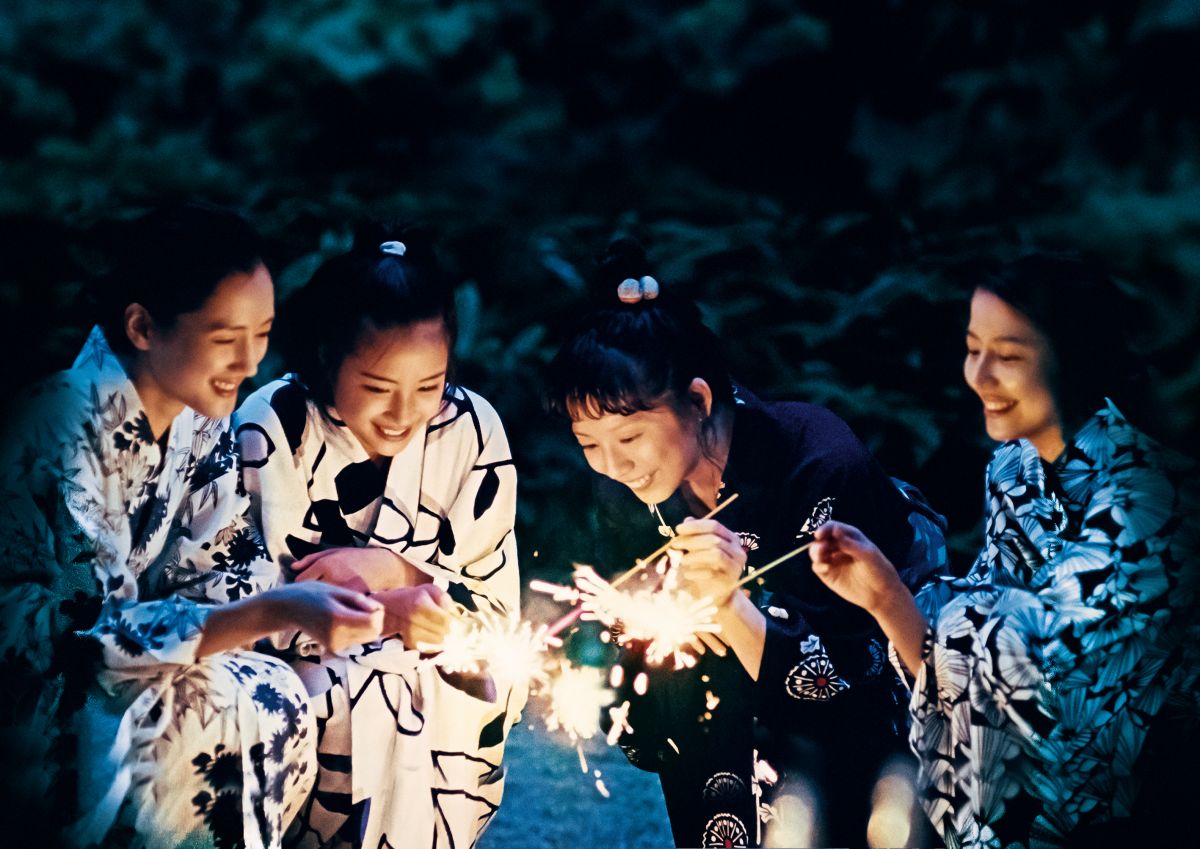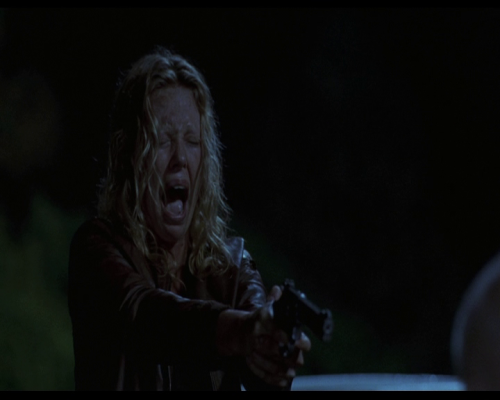This guest post written by Katherine Parker-Hay appears as part of our theme week on Sisterhood. | Spoilers ahead.
Ideas of the family seem to come interwoven with requirements of unconditional love. Whether we really like our siblings, whether we would have picked them out of a crowd, is beyond the point. The task is to love them as unthinkingly and uncritically as we can manage. But, with such black and white ideologies attached to what family means, the half-sister is surely always on precarious ground; her role seems like an oxymoron by nature. After all, when we think of sisters we tend to think less in halves and more in terms of too much: too much frustration, too much jealousy, too much love. From my experience at least, sisterhood is not something we do in half-measures. So when the half-sister encroaches on the space of the traditional family unit, what do we do with her? How do we make room for her? How does she transform us, if we let her?
Hirokazu Kore-eda’s Our Little Sister is a mature and subtle exploration of the place of the half-sister within family life; how she fits in and how she transforms what we think the family means. The story follows three adult sisters: Sachi (Haruka Ayase), who works in a hospital and is struggling because of an affair with a married man; light-hearted Chika (Kaho), who works in a sports shop; and Yoshino (Masami Nagasawa), who works in a bank and has an insatiable appetite for beer and dating. The three live comfortably together in a house left to them by their grandmother. Though not openly discussed, it is apparent that their parents had a difficult breakup, with their father having an affair and their mother disappearing. The siblings now live harmoniously together; however, this balance is disrupted when they are called to their father’s funeral, where they meet their long-estranged half-sister.
On meeting agnate-sibling Suzu (Suzu Hirose), the close-knit trio are forced to question whether a stranger could ever approximate the bond formed through having grown up together. Could this officious girl of a different generation meaningfully be a sister to them? With her nearing proximity, the girls are forced to consider the nature of relationships that seemed entirely natural and obvious. With so few shared points of reference, it would be easy for the sisters to turn away. However, something stops them. Saying a stilted goodbye at the station, the sisters on one side of the glass and the half-sister on the other, Sachi blurts out, “Come and live with us.” The camera lingers on Suzu’s face in a moment of indecision: will she go on as before, having no feelings for what are essentially strangers anyway, or will she take a leap of faith that will mean her identity will be forever tangled with theirs? As the doors close, she calls out, “I will.” Watching this as a child of a broken home left me near to tears. Suzu’s situation, as she considers whether to take the chance, seemed to encapsulate to me the position that a breakup can so often leave a child in: suddenly having to choose over what their family will look like and where its emotional and psychic boundaries will fall. Vulnerable and confused, we witness Suzu in the moment where she has to decide on what she can find enough room for within herself.
The film ambles subtly, Suzu having thrown in her lot with Sachi, Chika, and Yoshi, as it documents the small acts of the sisters making one another feel at home. This is not a simple task when all share such uneasy structural relationships with one another. Suzu starts off feeling awkward, inauthentic – a guest at the house belonging to the “real sisters.” To a friend, she confesses the precarious place that her family history has left her in: her “existence is the reason for other people’s pain.” However, as we watch the three girls in everyday activities like cooking, bathing, and lounging on the floor, we come to see that so much of what matters about being a sister is not the structural relation, the label imposed on the relationship from the outside, but the daily routines. It is the running to the bus together, the annual traditions like making plum wine.
As Suzu gradually becomes more comfortable, they even come to realize that there might be something very special about bringing a half-sister fully into their lives. They have chosen the relationship, chosen each other in the way that one might choose a partner or a best friend. Though not quite that. It is a choice far more willful, because they choose her against the weight of family history and against all the reasons that could have made it so easy to turn away.
Of course, the adult sisters find themselves in a situation that few children of divorced parents could dream of: on fleeing, the mother leaves the family home solely in their hands, to do as they wish. This situation could not be more different than when parents, siblings, half-siblings, and step-siblings, wounds still raw, are all brought together to cohabit under one roof. In such volatile living situations, the bloodlines seem almost fluorescent and, with just the slightest friction, can so quickly demarcate who belongs to whom. In contrast, Our Little Sister hands the protagonists a blank slate in the form of this expansive house that is all their own. They have the chance to establish relationships at a remove from the identity of their mothers and fathers. The empty house, with its excess of uninhabited rooms, becomes symbolic of a new kinship model. It is an elastic space, where they can encounter each other beyond the psychic confines of the Oedipal.
For the sisters, the house becomes a means of shutting out the wider world that would delegitimize their budding yet fragile relationship. The value of the neutral, insulating space of the house is made clear with a surprise visit from the three girl’s mother. During the visit, she casually relates that she is selling the house. She had been unhappy there and does not stop to imagine that her girls could relate any differently to the space. This is a failure of imagination – a failure to allow the children of divorce to move beyond the pain that their parent’s have left them as an inheritance. Similarly, their aunt warns the girls that they should be on their guard against the half-sister, after all, she reminds them, Suzu is “the reason for the breakdown of the parents.” For the aunt, the emphasis falls almost entirely on the half in half-sister, where it is synonymous with tainted and impure. Sachi has to remind her aunt that the affair had been well underway before Suzu was even born. Sachi refuses to reject her half-sister based on a sense of loyalty to her parent’s past, and so refuses the idea that she and her sisters must spend their lives forever reproducing the narrative of their parents’ pain.
Our Little Sister is a gentle probing of how much psychic room we have to create kinships that are more flexible and generous. This is a question often forced upon children of divorced families but, tragically, tends to come at a time when they are too young and too vulnerable for generosity. On the other hand, as adults these sisters have the distance and emotional availability to make space for their half-sister. The idea of this, making enough room for the half-sister, is beautifully illustrated in one of the film’s final scenes. The girls look at their heights at different ages, penciled onto a door frame. This remains an iconic image of family, where each penciled mark seems to boast so much: “my identity is here,” “I belong here, in the family home,” “I was here all along.” How can the half-sister find a place for herself when face-to-face with this? Here is an archive of proof that she came too late and has missed out on too much. Suzu gazes at this height-chart with deference, a late observer of the years already past. But then her sister nudges her and, in a moment that seems to willfully bend time, places a pencil line that definitely marks Suzu’s presence on the frame, in tandem with the others.
Katherine Parker-Hay has a BA in English from Goldsmiths University of London and an MA in Women’s Studies from University of Oxford. She writes on queer theory, women’s cultural output, temporality, and comic serials.







